IDENTIFICATION OF BROWN SWALLOWS
Tree, Bank, Northern Rough-winged
a web page by Don Roberson |
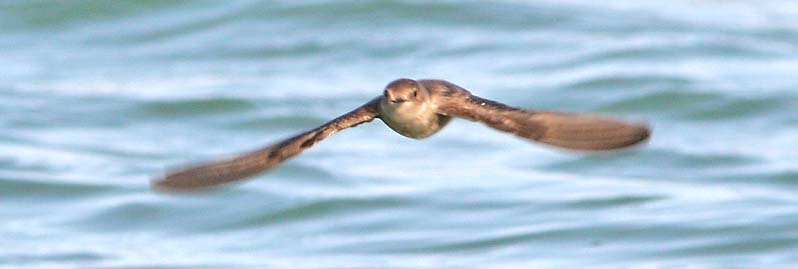 |
||||
 |
||||
|
||||
|
||||
| The problem in the fall is between juvenal Tree Swallow (below left) and Bank Swallow (below right). Both are brown above and white below, with crisp white throats. Tertial tips cannot be seen from the front or in flight views. Bank Swallow has a broad brown breastband, but the problem is that some young Tree Swallows have a partial to almost complete breastband. The one shown here (below left) has brownish sides to the breast; some others can be more extensively brown across the breast. The impression given in flight is of a brown swallow with a breastband. But while the breastband of Bank Swallow is crisp, broad, and well-defined, that of young Tree Swallow is ill-defined, dingy, and narrows or entirely peters out in the center. | ||||
|
||||
| It can be difficult to obtain good views of flying swallows, and there is variation in the breastband of Bank Swallows. The photo below shows two Bank Swallows. Both have broad breastbands, but one also has a 'spike' of dark downward from the center of the breast. Tree Swallow never shows anything like this downward spike (Wilds 1985, Lethaby 1996). I have not been able to find out whether this variation is age-related in any way, or simply just individual variation. But whether the 'spike' is present or not, a Tree Swallow with a 'breastband' never has a well-defined band that is as broad in the center as at the sides. | ||||
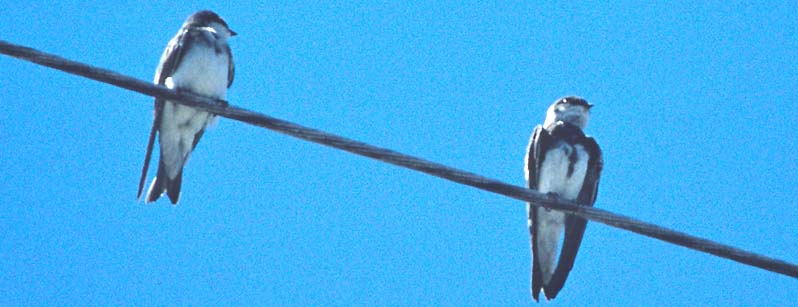 |
||||
When Tree and Bank Swallows are seen together, and particularly when sitting on a line together, it is very easily to separate them on size. Tree Swallow is decidedly larger. It is a third or more heavier; here are some average weights: Bank 13-14 gr, N. Rough-winged 13-16 gr, and Tree 18-24 gr [e.g., Garrison 1999]. Bank Swallow also typically shows more of a white crescent up behind the ear-coverts (see flight shot above) than Tree; but Tree can have an impression of an indentation here. [In hand, look for small tuft of feathers at base of hallux (hind tarsus) on Bank Swallow, lacking in Tree Swallow; Pyle 1997.] SEPARATING TREE SWALLOW FROM N. ROUGH-WINGED SWALLOW IN SPRING In spring the problems are different. Tree Swallow is unique among swallows in that it has a distinctive first-cycle female plumage. This is gained through pre-formative molt in the fall, and then first-alternate plumage is acquired by wear during winter. These first-cycle female Tree Swallows are brown. First-spring males look essentially like adult males. By spring the white tips to the tertials on Tree Swallows have worn off, although with very close views they may still show thin white edges. Any hint of breastband is much reduced (below left). But because they are brown, they can be confused with Northern Rough-winged Swallow (below right). |
||||
|
||||
| Tree and Rough-winged should not be confused from a front views, like these above. Tree Swallow has a very crisply delineated white throat, sharply demarcated from the brown face (above left). Northern Rough-winged Swallow has a fuzzy demarcation between the face and the paler throat. That paler throat and breast are washed with pale brown, of varying intensities, but they never give the impression of a crisply white-throated bird. There are some differences in bill size and proportions. Rough-winged has a longish and rather wide bill; that of Tree looks comparatively short and narrow. [The literature says that Tree has an operculum in the nostril and N. Rough-winged does not; I cannot detect the difference in photos.] | ||||
|
||||
| Above
is a first-summer Tree Swallow (above left) with a spring N.
Rough-winged Swallow (above right). Many birders are unaware that
first-cycle female Tree Swallows can bebrown. The Tree Swallow captured
at Big Sur R. mouth on 4 July 2000 (right) had worn to almost a sooty
color. Most of these first-year brown females do not breed, and they
are considered 'floaters' within a breeding population (Stutchbury
& Robertson 1985). The brown plumage of these first-years may
suppress aggression from the established pairs at nest sites by
indicating to the territorial male that the intruder is a female and to
the resident female that the intruder is subordinate (Stutchbury &
Robertson 1987, Turner & Rose 1989). A huge flight of Tree Swallows in mid-April 2008 contained a significant percentage of these first-year brown females when they were grounded by very high winds in the lower Salinas Valley (some of the photos on this page were taken then). Various observers noted this phenomena, and several expressed surprise that there should be "juveniles" this early in spring. In fact, the earliest fledglings known from MTY nests is 27 April (Roberson & Tenney 1993). There were not hundreds of fledglings two weeks earlier. There were, instead, many first-year females about. Tree and N. Rough-winged Swallows can almost always to separated in flight, without seeing the color of the throat, by the presence or absence of an extension of white flanks up onto the sides of the rump, present in most Tree Swallows and absent in all N. Rough-wings. This is illustrated by flight shots of an adult Tree (below left) and a brown first-spring female Tree (below right). Adults seem invariably to have these reduced 'flank patches' at the sides of the rump, but the first year swallows seem more variable in the extent of this patch. |
||||
|
||||
In summary, juvenal Tree Swallows are brown and may show indistinct breastbands, but can be separated from Bank Swallows by size, breadth and crispness of the breastband, white-tipped tertials, and face pattern. First-cycle female Tree Swallows are also brown into spring and summer, and present a field problem with Northern Rough-winged Swallow. These are separable on throat color, face/throat demarcation, and flank pattern in flight, plus small details of bill size, head shape, and (maybe) outer marginal covert pattern. |
||||
The non-MTY photos are: two Bank Swallows on telephone line was taken at Chester, Plumas Co., 17 Aug 2000; and the shots of the second perched first-spring Tree Swallow (a front view) and the second perched N. Rough-winged Swallow (a rear view) were digiscoped near Niland, Imperial Co., on 8 May 2008. Literature cited:
|
||||
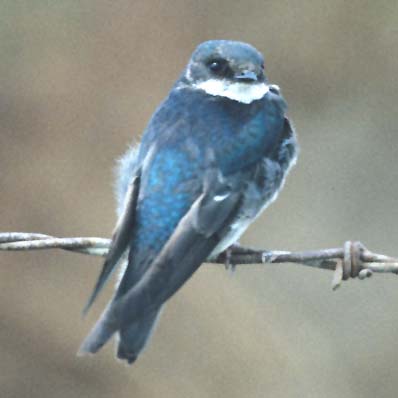
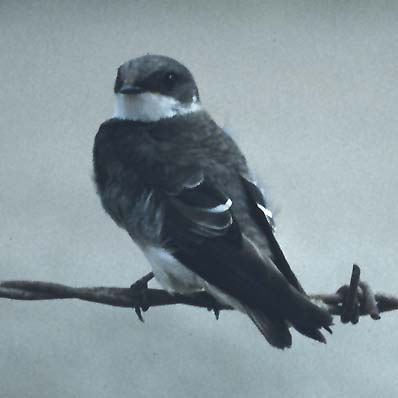

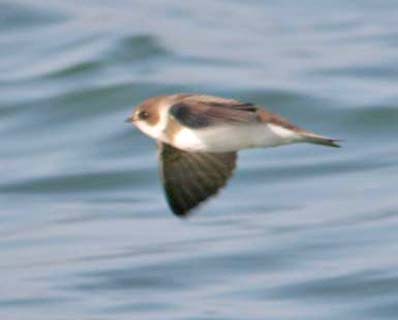
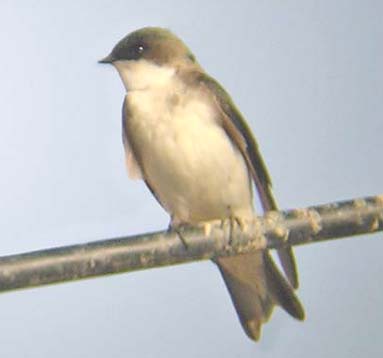

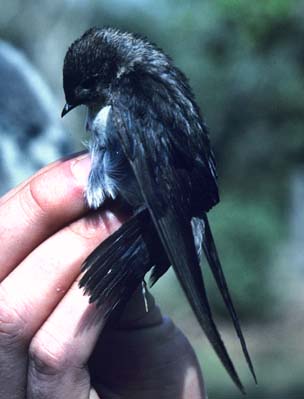
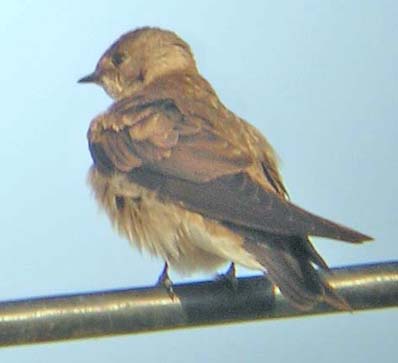

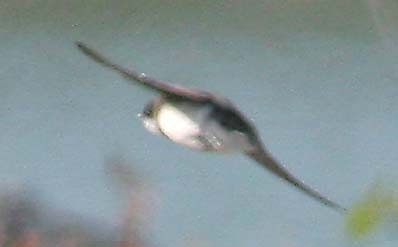
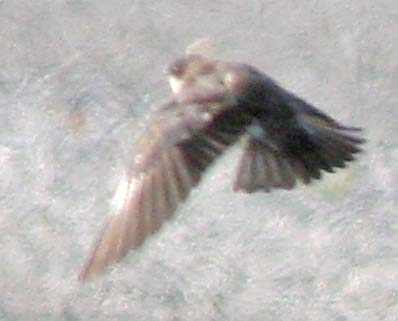 Finally,
consider this photo of one of the 'grounded' brown Tree Swallows in
mid-April (left). See that whitish patch at the base of the outer
primaries? I assumed this was just a function of odd lighting. But Pyle
(1997) describes how the distal marginal coverts average paler brown,
"contrasting markedly with the rest of the wing coverts," in
first-cycle females. For what is may be worth, the distal marginal
coverts are actually the upper left part of this whitish patch. Yet
surely the rest of it, seemingly encompassing the base of the outer
primaries themselves, is an artifact of lighting. Nonetheless, it is
interesting and I will be looking for this in other brown spring female
Trees.
Finally,
consider this photo of one of the 'grounded' brown Tree Swallows in
mid-April (left). See that whitish patch at the base of the outer
primaries? I assumed this was just a function of odd lighting. But Pyle
(1997) describes how the distal marginal coverts average paler brown,
"contrasting markedly with the rest of the wing coverts," in
first-cycle females. For what is may be worth, the distal marginal
coverts are actually the upper left part of this whitish patch. Yet
surely the rest of it, seemingly encompassing the base of the outer
primaries themselves, is an artifact of lighting. Nonetheless, it is
interesting and I will be looking for this in other brown spring female
Trees.